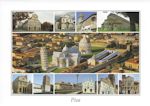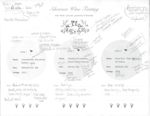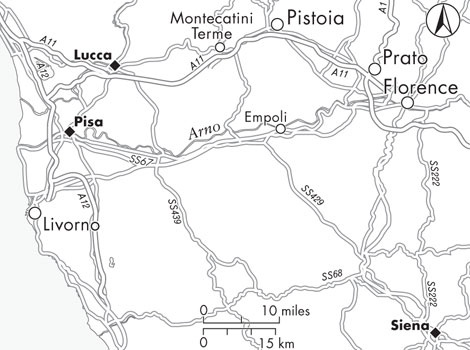Mediterranean Cruise 2012 |
|
|||||||||||||||||
Links to Port Pages
|
Livorno, ITALY - Port for Florence and Pisa Saturday, 17 March: We sailed into Livorno early Saturday morning. The ship overnighted in Livorno which allowed us a day in Florence and then a tour to Pisa on Sunday. Livorno is, as Frommer's describes, rather gritty and not very interesting. But 10 minutes from the cruise port is the train station and access to the towns of the region. Let us first tell you that if you are cruising to Livorno, or most of the Italian ports, and want to take the train we found the best information and "How To" instructions on a website before we left. We copied the article on taking the train to Florence into a Word document and carried it with us on the trip for reference. Mediterranean Cruise Ports Easy (Click the link to go to their website) - The authors and owners of this site have written numerous instructions that make it absolutely EASY, just as they claim. If you go to the 'Cruise Florence' link and then scroll down towards the bottom you will see a link to an article called 'Travel to Florence by Train'. The article, complete with pictures, tells you exactly what to do, and not to do, to successfully travel by train. The only part we did not need was walking or taking a bus into the central Piazza Grande as taxis were available right outside the security fence where we were docked. Taking the taxi to the station is worth it - time wise. Our taxi driver took all four of us for $15 Euros and the drive was less than 10 minutes. We easily made the 9:06 am train with time to spare. The train arrived at Firenze S.M.N. (Sante Maria Novella) about 10:30 a.m. Note that this is the second stop in Firenze and the one you need to use if you are going to the major sites. It is easy walking from the station to nearly all of the museums and churches you want to visit, including the Ponte Vecchio! The first place we wanted to go was to the Accademia Gallery. The museum is known throughout the world as the "Michelangelo Museum" because it houses the sculptures of the 'Slaves' group and the 'David'. We followed our map and wandered the streets passing by the Duomo until we reached the museum. Across the street and a few metres away was a ticket shop where you could pay a few euros more and get a specific time to enter. This saved us a long wait in the "No reservations" line. The museum did not allow photography even without a flash so we have no pictures ourselves. The photo in the slideshow is a scan of a postcard! The statue of David is truly incredible. The detailed smooth surfaces exhibit veins and muscles that appear to be real. Michelangelo's skill cannot really be seen unless you are as close as you can get to the real sculpture. We were able to walk all around it within fairly close proximity. What none of us realized from photos is that the arms, hands, legs and feet are very oversized - out of proportion - to the body. Michaelangelo carved the sculpture in 1501-1504 to be viewed from a distance as the 'perfect' model. The sculpture was originally placed outside of the Palace Vecchio, but moved to the Accademia in 1873. We also had the opportunity to view the incomplete sculptures of the 'Slaves', numerous paintings and plaster casts from the 14th and 19th centuries. We pre-purchased tickets to the Uffizi Gallery for a 1:30 pm entry. As we walked in the direction of the Uffizi, Amy noticed a small restaurant with outdoor seating in a side street. Bar San Michelle. We had a wonderful lunch of calzone and pizzas. Perfect break before exploring the Uffizi. After lunch we walked a few more blocks and entered the Piazza degli Uffizi. The Palace Vecchio is at one side of the Piazza with a copy of the David statue and a statue of Neptune. We did not have tickets for the palace so walked down the street to the Uffizi. As we walked we started to hear "smooches" noises - someone making loud kisses. We finally noticed a mime dressed as Cupid. He was really very lively and entertaining. Both Amy and I spent a few minutes and had some pictures taken with him. Then we entered the Uffizi. The Uffizi Gallery is actually on the top floor of the former administrative and judicial offices (uffizi) building built in 1560 and connected to a Medici residence at Palazzo Pitti. Medici Duke Cosimo I and his son Francesco I established the first European museum in 1581 as a gallery a "place for walking, with paintings, statues, and other precious things." The centerpiece artworks in the Uffizi are the Botticelli paintings. There are 15 in the collection, including the 'Birth of Venus', 'Primavera', 'Madonna of the Pomegranate', and 'Adoration of the Magi'. Unfortunately the Rubens and Rembrandt rooms were closed during our visit. We purchased the museum's official guide as a souvenir, but also to read more about the collections that are maintained in the gallery. We left the gallery and walked along the river Arno to the Ponte Vecchio. We looked at a few shops but TJ had noticed a wine bar on the other side of the river from the Uffizi, so we headed over for a respite. The bar/restaurant had great wine and served olives and almonds that were the best we had ever tasted! A definate "pick me up". As we walked back to the Ponte Vecchio Randy and I saw an artist doing watercolors of the bridge and surrounding area. As we looked more closely we could see that his technique also included full reflections in the river surface. Very nice work. So we purchased one and safely transported it home, soon to be hung with our other artwork, mostly watercolors, from our travels. A little shopping on the Ponte Vecchio and we were ready to think about dinner. Two stories to share with you. First - Randy had told us the last time he was on a train in Italy the trains had gone on strike while he was traveling. When the train stopped, the people got off in a large field, spread blankets and had "picnics" while they waited for about 3 hours. Fortunately he was able to join with some folks. Then the whistle blew, everyone got back on the train, and headed on to their destinations. He had asked folks on the internet before we traveled if the trains went on strike anymore and everyone who responded said not in a long time. Second - Randy had visited Florence many years ago when he worked in Germany. He remembered having Steak Florentine at a restaurant in the Piazza della Repubblica and that it was extraordinary. We wanted to try and find the restaurant again. As we were starting to get tired and hungry Randy suggested we try and eat and head back to Livorno a little earlier than we had originally planned. It was getting dark and had been a long day. As we entered the Piazza we looked for the restaurant and the location is now a bank. But no worries, there were three other restaurants along the same side and we finally settled on Pescerosso. The majority of the main entrees are fish based, but we all chose a terrific chicken scallopini, with gnocchi for an appetizer, and good Italian wine. We would highly recommend this restaurant to anyone visiting Florence. Completely full and content we found a taxi and headed to the train station to catch the 8:53pm train back to Livorno. There were very few people on the train that night. It was also St Patrick's Day, but we were in Italy so didn't think that would be a big celebration! The train actually slowed and stopped a few times along the way and then arrived into Livorno right on time at 10:24 pm. As we went into the station we noticed that everything was closed up and dark. Only two taxis were waiting outside. We did not know the evening schedule leaving Livorno, but there were two more trains scheduled to come in after ours. We had originally planned to take the 10 pm train back from Florence. We closed the night with a brief nightcap and went to sleep, dreaming of our day and our tour to Pisa on Sunday.
Sunday, 18 March: We met up for breakfast before our tour to Pisa and started to hear that passengers had gotten "stuck" in Florence and had not made it back to the ship the night before. As the stories began to come out we learned that the trains had gone on strike at 10:30 last night!! 6 minutes after we got back to Livorno!! If we had not eaten dinner a little earlier than planned and taken the 8:55 pm train we would have been stuck in Florence also! A near miss! Thank goodness Randy told us his train story and we did not have a repeat of his previous luck! Today we took the ship's tour to Pisa and arrived at the Piazza del Duomo ("Cathedral Square") which is a wide, walled area at the heart of the city of Pisa. Inside the wall is the Piazza dei Miracoli (Square of Miracles). Just a half day tour, but again, seeing four great religious edifices: the Duomo (cathedral), the Campanile (the cathedral's free standing bell tower), the Baptistry and the Camposanto was a wonderul experience. We spent nearly three hours wandering the square, picked up a few postcards, and enjoyed a cappuccino and gelato before boarding the bus to reurn to the ship. We returned in time to go to the Wine Tasting Seminar on 'Wines of Italy" with the guest lecturer. It was a real learning experience for me. TJ is our group "wine taster extraordinaire" who never steered us wrong. The seminar was helpful to start picking up on some of the nuances of "flavors and notes" in wine. We tried three wines - 2010 Fontanafredda Barbera fromPiedmont, IT; 2006 Castellare Di Castellina Chianti Classico Riserva from Tuscany; and 2006 Elena Fucci Titolo Aglianico from Basilicata, Italy. All were good, but we enjoyed the Barbera and Chianti Classico the best. Tonight was a formal evening with dinner and dancing in the Restaurant. After dinner we went to a classical violin and piano recital. Colin Brown, the cruise director, is a classically trained pianist. The cruise line had a guest violinist, Peter Fisher, appear for a few evenings and Colin joined him on this evening. After another very full day, it was definately bedtime - as tomorrow we go to Rome!
Postings before the Trip: We are scheduled to arrive in Livorno, Italy Saturday morning, 17 March 2012 at 8:00 am. We will overnight in port to allow two days to go to Florence and Pisa, Italy.
From Wikipedia - "Florence is the capital city of the Italian region of Tuscany and of the province of Florence. It is the most populous city in Tuscany, with c. 370,000 inhabitants (1,500,000 in the metropolitan area). The city lies on the River Arno; it is known for its history and its importance in the Middle Ages and in the Renaissance, especially for its art and architecture and, more generally, for its cultural heritage. A centre of medieval European trade and finance and one of the wealthiest cities of the time, Florence is considered the birthplace of the Renaissance; it has been called the Athens of the Middle Ages. A turbulent political history included periods of rule by the powerful Medici family, religious and republican revolution. From 1865 to 1870 the city was also the capital of the recently established Kingdom of Italy. The historic centre of Florence attracts millions of tourists each year, and Euromonitor International ranked the city as the world's 72nd most visited in 2009, with 1.685 million visitors. It was declared a World Heritage Site UNESCO in 1982. Due to Florence's artistic and architectural heritage, it has been ranked by Forbes as one of the most beautiful cities in the world, and the city is noted for its history, culture, Renaissance art and architecture and monuments. The city also contains numerous museums and art galleries, such as the Uffizi Gallery and the Pitti Palace, amongst others, and still exerts an influence in the fields of art, culture and politics." "Pisa is a city in Tuscany, Central Italy, on the right bank of the mouth of the River Arno on the Ligurian Sea. It is the capital city of the Province of Pisa. Although Pisa is known worldwide for its Leaning Tower (the bell tower of the city's cathedral), the city of over 88,332 residents (around 200,000 with the metropolitan area) contains more than 20 other historic churches, several palaces and various bridges across the River Arno. The city is also home of the University of Pisa, which has a history going back to the 12th century and also has the mythic Napoleonic Scuola Normale Superiore di Pisa and Sant'Anna School of Advanced Studies as the best Superior Graduate Schools in Italy."
Update 22 January 2012: Our first day we plan to take the train to Florence and spend the day exploring on our own. For the second day we scheduled an excursion to Pisa through the ship. From the Silversea Website Tour List - "Monuments of Pisa 18 Mar 2012 | 4-4.5 Hours | Morning Discover the beauty of Pisa during this scenic, half-day tour of the city's historic landmarks, including the world-renowned Leaning Tower of Pisa. Since the beginning of the tourist brochure, Pisa has been known for just one thing, the Leaning Tower. However, this world-renowned landmark is but one component of the city's amazing religious core, the Campo dei Miracoli. Here, the Duomo, Baptistery and Camposanto complete an unrivalled quartet of Medieval masterpieces. These and a dozen or so churches and palazzo scattered about the town belong to Pisa's 'Golden Age', which took place from the 11th to the 13th centuries when the city was still a port, and one of the maritime powers of the Mediterranean. Depart the pier for the approximately 45-minute drive to Pisa. Pisa Upon arrival at the parking area, walk to the Campo dei Miracoli and commence the guided portion of your tour. Campo dei Miracoli Since it was first laid out, Pisa's ecclesiastical centre has been known as the Campo dei Miracoli, or 'Field of Miracles'. The sight of it is as stunning today as it must have been to Medieval travellers. Nowhere in Italy are the key buildings of a city arrayed with such precision, and nowhere else is there so beautiful a contrast of stonework and surrounding meadow. Leaning Tower of Pisa Your next stop is the Leaning Tower of Pisa. Underneath the pavement and turf of the Campo dei Miracoli lies a platform of saturated sandy soil, whose instability accounts for the tilting of the Leaning Tower. Begun in 1173, construction of the tower subsided when it had reached just three storeys in height. Over the ensuing 180 years, a succession of architects continued to extend it upwards until it was finally completed and topped with a bell-chamber in 1350. Leaving the Leaning Tower, proceed to the Duomo. The Duomo The Duomo was built in 1064, a century before the Campanile. With its four levels of variegated colonnades and subtle interplay of dark grey marble and white stone, the Duomo is the archetype of the Pisan Romanesque style; a model often imitated but never surpassed. The Baptistry A visit is then made to the Baptistry. The third building of the Miracoli ensemble, the circular Baptistery is a bizarre mix; its three storeys of Romanesque arcades peak in a crest of Gothic pinnacles, and its dome is shaped like the stalk of a lemon. Piazza dei Cavalieri Leaving the Campo dei Miracoli, visit the Piazza dei Cavalieri. One of Pisa's most interesting sites, the Piazza dei Cavalieri is a large square that opens unexpectedly from the narrow back streets, and includes the site of the Roman Forum. The central civic square of Medieval Pisa, the Roman Forum was subsequently remodelled by Vasari and became the headquarters of the Knights of St. Stephen. Palazzo dell'Orologio On the western side of the square is the Renaissance-adapted Palazzo dell'Orologio. In 1208, the military leader Ugolino della Gherardesca, along his sons and grandsons, was starved to death in its tower as punishment for his alleged duplicity with the Genoese enemy. Following your guided walking tour, some free time is made available for independent exploration before walking back to the parking area and re-boarding the coach for the approximately 45-minute drive back to the pier."
|
||||||||||||||||
|
|||||||||||||||||

















